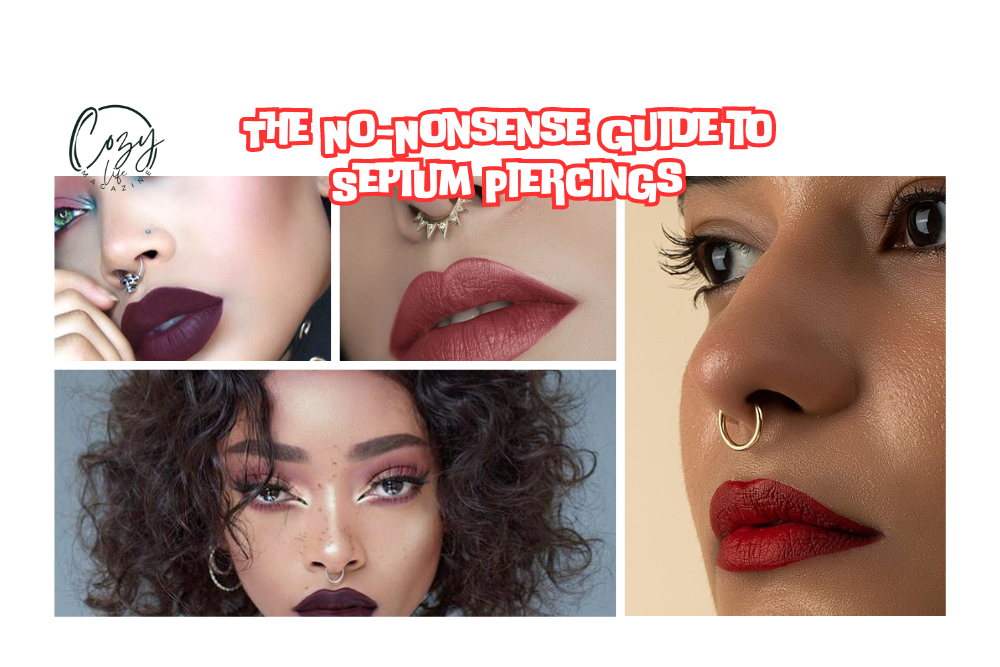Septum Piercing 101: Pain, Healing, Costs, and Jewelry Recommendations
Septum piercings are making a big comeback this year, thanks to their growing popularity in fashion magazines and on the red carpet. With more celebrities and models sporting septum rings, this piercing has become a trendy accessory once again. If you’ve been thinking about getting one but weren’t sure if it’s the right time, now might be the perfect opportunity to embrace this bold look.
However, getting a septum piercing is more than just a fashion statement. Like any body modification, it requires research and responsibility. You’re piercing a hole through your body, and that comes with a need for careful aftercare and a skilled piercer to ensure it’s done right. In this article, we’ll walk you through everything you need to know about septum piercings, from the pain level to choosing the right jewelry.
Whether you’re a piercing enthusiast or someone considering your first, understanding the process is key to making the right decision. We’ll cover all the basics, from how septum piercings are done, to tips on finding a reputable piercer, and even what to expect during the healing process. Let’s dive into the world of septum piercings and help you make an informed choice!
What Is a Septum Piercing?
A septum piercing is a trendy yet bold type of nose piercing that goes through the soft tissue between your nostrils, not the cartilage. Your piercer will aim for the “sweet spot,” a thinner area of tissue called the columella. Since everyone’s anatomy is different, the exact placement may vary, but the goal is to find the spot that provides the best location for your jewelry. The septum piercing is known for its versatility in jewelry styles and the ability to be hidden by flipping the ring upward, making it perfect for those balancing a bold look with professional settings.
While septum piercings are considered relatively easy, a successful piercing depends heavily on both your anatomy and the skill of your piercer. Some people may have a deviated septum, uneven nostrils, or old injuries, which can affect how the jewelry sits. In these cases, it might take a bit of patience and communication with your piercer to get the right result. However, with proper care and a reputable piercer, most people can enjoy the unique and stylish look of a septum piercing.
Fast Facts: Septum Piercing
| Aspect | Details |
|---|---|
| Placement | Septum, the layer of cartilage between the nostrils |
| Cost | $40 – $100 |
| Pain Level | 7/10 |
| Healing Time | 4 to 6 months |
| Aftercare | Soak with saline twice a day; avoid touching; keep products away |
| Jewelry Options | Horseshoe barbells, captive rings, and clickers |
| Visibility | Can be hidden by flipping the jewelry up inside the nose |
| Deviated Septum | May complicate the piercing but is manageable with an experienced piercer |
| Infection Risk | Low with proper care; saline soaks help minimize issues |
| Piercing Process | Performed with a sterile single-use needle through the “sweet spot” |
Can Anyone Get a Septum Piercing?
Not everyone is a candidate for a septum piercing. Your anatomy plays a big role, as the piercing must go through the soft tissue below the cartilage in your nose. If you have a deviated septum or thick cartilage in that area, you may not be an ideal candidate for this piercing.
The Piercing Process: What to Expect
When you arrive for your septum piercing, the first step is to ensure cleanliness and hygiene. Your piercer will begin by cleaning your nose with an iodine solution to eliminate bacteria and prepare the area. The jewelry and tools used during the procedure are thoroughly sterilized to prevent infection. This is also the time when your piercer may discuss any anatomical concerns, like a deviated septum, which could impact the piercing’s placement. As experienced piercers know, slight deviations can make it difficult to get the jewelry perfectly straight, and some adjustments might be necessary.
Now comes the piercing itself, which can vary slightly depending on the piercer’s technique. Some piercers prefer the client to sit upright against a backrest, while others may have you lie down. The piercing is done using a single-use needle, and while some piercers use clamps to hold the septum in place, others rely on their hands and skill to guide the needle through the “sweet spot.” After the piercing is complete, your selected jewelry is inserted, and the area is cleaned with a sterile saline solution. Once that’s done, you’ll be all set with your new look! The process is quick but requires attention to detail, so choosing an experienced piercer is key.
Can I Get a Ring Right Away?
Most piercers will recommend starting with a horseshoe barbell or a curved barbell, as these are easier to heal with. Rings may cause irritation during the healing process because they move around more. Once your piercing is fully healed, you can switch to a ring.
How Much Does a Septum Piercing Hurt?
Contrary to popular belief, septum piercings aren’t as painful as many imagine. There’s a common misconception that septum piercings hurt significantly due to their location, but this largely stems from people mistakenly piercing the septum cartilage instead of the “sweet spot.” The sweet spot is a thin area of tissue located just below the cartilage, and when pierced correctly, the discomfort is minimal.
For most, the pain level is surprisingly low. You may feel a quick pinch followed by slight pressure as the needle passes through the sweet spot. Many people report that the sensation is more of a tug than sharp pain. One thing you should expect, though, is some teary eyes—not from the pain, but because of the piercing’s proximity to the tear ducts.
However, if your sweet spot is smaller or if the cartilage needs to be pierced due to your anatomy, the pain level might be higher. In rare cases where people lack a distinct sweet spot, piercing the cartilage can increase discomfort. But for the majority, septum piercings rank lower on the pain scale than other nose piercings, like the nostril piercing. Finding an experienced piercer is crucial to ensure you get the best placement and minimize pain.
How Long Does It Take to Heal?
The healing time for a septum piercing can vary depending on the location of the piercing and your body’s healing ability. If your piercer hit the sweet spot, which is the thin, soft tissue just below the cartilage, your septum piercing should heal within 6 to 8 weeks. During this time, you’ll likely feel much better as the soreness subsides, but don’t be fooled—just because it feels better doesn’t mean it’s fully healed.
If your septum was pierced through the cartilage instead of the sweet spot, the healing process will be much longer. In these cases, it can take at least 6 months or more before the piercing is completely healed. Cartilage piercings require more time and patience, as cartilage heals more slowly than soft tissue.
For most people, the piercing may feel healed after 8 weeks, but it’s important to continue with your aftercare routine and consult your piercer before stopping. Complete healing can take anywhere from 4 to 6 months, and it’s crucial to avoid changing jewelry too early, as the tissue inside the piercing still needs time to strengthen. Waiting until your piercer confirms the healing process is complete will help you avoid complications or setbacks.
Tips for Healing a Septum Piercing
Healing a septum piercing requires patience, proper care, and consistency. While septum piercings are known to heal relatively quickly compared to other piercings, improper aftercare can lead to complications such as infection, irritation, or prolonged healing times. Below are some essential tips to ensure your septum piercing heals smoothly and without issues.
1. Follow Aftercare Instructions Diligently
Your piercer will provide specific aftercare instructions tailored to your healing process. It’s crucial to follow these instructions closely, as they are designed to minimize the risk of infection and promote faster healing. The general guideline involves cleaning your piercing twice a day with a saline solution (a mixture of non-iodized sea salt and sterile water). Avoid using harsh soaps or alcohol-based products, as these can irritate the skin and slow down the healing process.
2. Avoid Touching Your Piercing
One of the most important things you can do to promote healing is to avoid touching your piercing unnecessarily. Touching your piercing with dirty hands introduces bacteria, which can lead to infections. If you need to touch or adjust your jewelry, make sure your hands are thoroughly washed with antibacterial soap. Even then, try to minimize contact to avoid irritation or dislodging the jewelry.
3. Keep the Area Clean, But Don’t Over-Clean
While keeping your septum piercing clean is critical, over-cleaning can be just as harmful as neglecting it. Using a saline solution twice a day is sufficient; cleaning more often can dry out the skin and cause additional irritation. After each cleaning, allow the piercing to air dry or gently pat it with a clean, disposable paper towel. Avoid using cloth towels, as they can harbor bacteria and cause unnecessary friction.
4. Watch for Signs of Infection
During the healing process, it’s natural to experience some redness, slight swelling, and tenderness, especially during the first few days. However, if you notice excessive swelling, severe pain, pus, or any unusual discharge, it may be a sign of infection. If you experience any of these symptoms, consult your piercer or a healthcare professional immediately for advice. Early intervention is key to preventing more serious complications.
5. Avoid Changing Jewelry Too Soon
Even though your septum piercing may appear healed after a few weeks, it’s important to remember that full healing can take anywhere from 4 to 6 months. During this time, avoid changing your jewelry unless absolutely necessary. Changing your jewelry too soon can disrupt the healing process, reopen the wound, or introduce bacteria into the piercing site. Once fully healed, consult your piercer before changing the jewelry for the first time.
6. Be Mindful of Activities and Environment
Certain activities can interfere with your septum piercing’s healing process. For instance, if you participate in contact sports, it’s essential to be cautious to avoid hitting or bumping your nose. Additionally, exposing your piercing to harsh environments, such as pools, lakes, or hot tubs, can introduce harmful bacteria and slow the healing process. If you must swim, be sure to protect your piercing and clean it immediately afterward with saline solution.
7. Sleep with Care
Sleeping with a new septum piercing can be tricky, as pressure on the nose can cause discomfort and irritation. To avoid accidentally bumping or pressing on the piercing, try sleeping on your back or use pillows to create a comfortable sleeping position that doesn’t disturb the nose. If you sleep on your side or stomach, be mindful of keeping your nose away from the pillow to minimize pressure on the piercing.
8. Watch for Allergic Reactions
If you experience persistent itching, rash, or swelling beyond the initial healing stage, you might be having an allergic reaction to the jewelry material. Always choose high-quality, hypoallergenic metals such as implant-grade titanium or 14k or 18k solid gold to avoid allergic reactions. If you suspect an allergy, consult your piercer for advice and consider switching to safer materials.
Types of Jewelry for Septum Piercings
Once your septum piercing is fully healed, a whole world of jewelry options opens up. Whether you prefer something bold and eye-catching or subtle and understated, the versatility of septum piercings allows for endless customization. Let’s explore the most popular types of septum jewelry that can elevate your look.
- 1. Circular Barbells (Horseshoe Rings) Circular barbells, often referred to as horseshoe rings, are a classic choice for septum piercings. The shape resembles a horseshoe, and the jewelry dangles just below the nose. Many people opt for this style because it’s practical—it can easily be flipped up inside the nostrils to hide the piercing when needed. If you want to add some flair, you can choose beads with different materials like opals, diamonds, or even colorful stones for a personalized touch.
- 2. Captive Bead Rings Another popular option, especially for those just starting with their piercing, is the captive bead ring. This style is a closed hoop with a bead that “caps” the ends together. The bead not only serves as a secure fastener but also offers room for decorative choices, such as shiny metals or gemstones. This ring is simple to insert and adds elegance to a standard septum look.
- 3. Seamless Rings If you’re into a sleek, minimal design, seamless rings are perfect once your piercing is fully healed. These rings, also known as seam rings, create a clean and continuous loop through the septum with no visible closure. Although they can be a little tricky to insert, their delicate, seamless design adds sophistication to any style and pairs well with both casual and formal looks.
- 4. Clicker Hoops For those who want to make a statement, clicker hoops are the way to go. This type of septum jewelry features a hinged mechanism that snaps into place, making it both easy to wear and incredibly secure. Clickers come in a wide variety of intricate designs, from simple geometric shapes to bold, ornate patterns. Because of their unique design, they tend to stand out and are great for people who love to showcase their piercing as a focal point.
- 5. Septum Stacking A rising trend in the world of septum piercings is septum stacking, where multiple rings are worn through the same piercing. For those with a stretched septum, stacking creates a layered, dynamic look that can be customized with various styles and metals. This style is ideal for anyone who wants to add dimension and creativity to their piercing while experimenting with different sizes and materials.
Best Materials for Septum Jewelry
When it comes to material, it’s important to prioritize quality to ensure your piercing stays healthy and irritation-free. Most piercers recommend using jewelry made from implant-grade titanium or solid 14k or 18k gold. Both materials are hypoallergenic and safe for long-term wear, making them ideal choices for septum piercings. These high-quality metals also offer a polished finish, whether you’re going for a dainty, delicate look or something bold and dramatic.
By choosing the right style and material, your septum piercing can be a unique expression of your personal style that enhances your overall look.
FreshTrends Tip
Septum piercings can make blowing your nose a little more challenging, especially during the healing phase. If you suffer from chronic sinus issues, allergies, or nasal problems, it might be best to avoid septum piercings altogether.
Potential Side Effects of Septum Piercings
While septum piercings are generally considered safe, it’s important to be aware of potential side effects that can arise during the healing process. Proper aftercare and precautions can minimize these risks, but understanding what to look out for is essential to ensure a smooth recovery. Here are some common side effects:
- Infection: Bacterial infections are a common risk with any piercing. Symptoms include persistent redness, swelling, unusual discharge, and warmth around the piercing area. If untreated, infections can become severe, so it’s important to keep the area clean and consult a healthcare professional at the first sign of an infection.
- Swelling: Mild swelling is normal during the first few days of healing. However, excessive or prolonged swelling can indicate irritation or an allergic reaction. Using cold compresses and following aftercare routines can help manage swelling, but if it persists, visit your piercer or a doctor.
- Allergic Reactions: Some people are allergic to certain types of metals used in piercing jewelry, such as nickel. This can lead to itching, redness, and swelling. To avoid this, use hypoallergenic materials like implant-grade titanium or solid 14k or 18k gold.
- Pain or Discomfort: Initial discomfort is normal, but if pain persists beyond the first few days, it could indicate a problem with the placement or the jewelry. If pain worsens over time, consult your piercer for an evaluation.
Changing Out a Septum Piercing
Once your septum piercing has fully healed, which typically takes anywhere from 4 to 6 months, you may want to change your jewelry. However, changing jewelry prematurely can irritate the piercing and slow the healing process. When it’s time for a switch, follow these steps to ensure a smooth and sterile change:
- Wash Your Hands: Always clean your hands thoroughly before handling the piercing or the new jewelry. This helps prevent the introduction of bacteria.
- Use Sterile Tools: If you’re removing or inserting jewelry on your own, make sure any tools or jewelry you’re using are sterilized. Avoid using dirty or contaminated items that can cause an infection.
- Consult a Piercer: If you’re unsure about changing your jewelry, it’s best to visit your piercer. They can safely remove the old jewelry and replace it with the new one, minimizing the risk of irritation or infection.
Hiding Your Septum Piercing
One of the most versatile features of a septum piercing is the ability to easily hide it. By choosing a horseshoe barbell, you can flip the jewelry up inside your nostrils, making it virtually invisible to others. This is especially useful for situations where piercings might not be appropriate, such as at work or family gatherings. When flipped up, the horseshoe ring is discreet and easy to manage.
Does the Hole Close Up?
If you decide that your septum piercing is no longer for you, the hole may close up over time. How quickly this happens depends largely on how long you’ve had the piercing. If the piercing is fresh or not fully healed, the hole can close within a few days or weeks. However, if you’ve had the piercing for several years, it may never close entirely, leaving a small, barely noticeable hole.
For those who might want to keep the option of wearing the piercing in the future, it’s a good idea to leave the jewelry in for longer periods to prevent closure.
Additional Tips for Septum Piercings
- Avoid Makeup and Skincare Products: Keep makeup, lotions, and other skincare products away from the piercing to prevent irritation. These can clog the piercing and introduce bacteria, which may lead to infection.
- Choose the Right Jewelry: Always opt for high-quality jewelry made from materials that are safe for long-term wear, such as titanium, surgical steel, or solid gold. Avoid cheap or untested metals that could cause allergic reactions.
- Stay Consistent with Aftercare: Even if your piercing appears to be healed after a few weeks, continue following your piercer’s aftercare instructions for at least the recommended healing period to ensure complete recovery.
If you’re considering getting a septum piercing, there’s no better time to take the leap. This versatile and edgy piercing has gained popularity for its ability to suit a wide range of personal styles, offering endless options when it comes to jewelry choices. Whether you’re going for something bold and eye-catching or subtle and discreet, a septum piercing can easily become a unique expression of your individuality.







